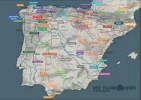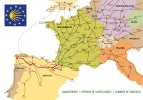First, please allow me to say that I TOTALLY agree with VNwalking's OP.
Second, I also concur with near everything written above.
Third, please allow me to interject some historical reference and context:
The FIRST documented camino, post discovery, of the storied bones by the hermit monk Pelayo, and the resulting Papal Bull proclaiming these to be the relics of Santiago, was by the King of Asturias. The route he followed to Santiago is considered to be the present day Camino Primitivo route, more or less. He walked / rode horses (?) from his castle in Oviedo, to Santiago.
MOST, but certainly not all of the pilgrims coming from more northern parts of Europe, over the Pyrenees had to make their way over those mountains to get into the then Kingdoms of Asturias Navarre, Aragones or Catalonia, and thence journey to venerate the relics at (what would become) Santiago de Compostela. To do so, they typically, had to avail themselves of four known passes through or around the Pyrenees mountains.
From West to east, these routes are the coastal area near present day Irun, the Roncesvalles Pass or Passage du Cize (now Napoleon Pass) at present day St. Jean Pied de Port, the Somport Pass south of Pau and to the southwest of Lourdes, and the coastal area north of Barcelona.
The Somport Pass was arguably the most popular Pyrenaic pass for pilgrims on the Way of St. James until the pacification of Navarran and Basque bandits in the 12th century made the relatively easier Roncesvalles road safer for pilgrims. From then, the Roncesvalles Pass or Passage du Cize (what we now call the Napoleon Pass) and St Jean-le-Vieux, later St. Jean Pied de Port, became the most popular starting or jump-off place. (I got the bit in italics from Wikipedia...)
However, beginning in the 12th century (1100s), the majority of pilgrims coming from the north transited the Pyrenees at the Roncesvalles Pass or Passage du Cize (now Napoleon Pass.) They first had to stop at the village / town of St Jean-le-Vieux, later St. Jean Pied de Port to rest, recover, outfit and prepare themselves for the arduous journey ahead.
This is why the folks in St. Jean Pied de Port proudly tell pilgrims that they have been outfitting and sending pilgrims off to Santiago de Compostela for more than 1,100 years... because they have. Their experience sending off pilgrims started in the late 800's they have been at it ever since.
This political change in the 1100s gave rise to the emergence of the
Camino Frances being the virtual spine of the route of the
Camino de Santiago. One has only to look at a map of the routes to understand this relationship. (See the BIG Map). Many of the early Camino routes flow into the
Camino Frances, like tributaries into the main river.
To be sure, in later centuries, other personages made other routes more popular. The Kings and Queens from Portugal (or the Kingdoms later becoming Portugal) would travel via the traditional interior route of the Camino Portuguese. Persons of note, rank or historical significance also traveled south to Santiago on the Camino Ingles, having first arrived at Ferrol by boat.
They also traveled from Sevilla and the south of Iberia on the Camino Via de la Plata. I also believe, IIRC, that some folks came from the west from Barcelona.
Other routes were developed and documented along the way. Some routes, while considered OLD are relatively new.
For example, the Camino Invierno from Ponferrada, has been around for hundreds of years, but does not date from medieval times. The route from Madrid is also a fairly modern contrivance. this does not detract from the importance of these routes, it merely puts them into a historical context.
Very significantly, in 1213/14, Francis of Assisi (still alive then and not yet a saint), accompanied by two of his followers, departed Assisi, walked to Rome to meet with the Pope, then continued up and west over or near the present Cinque Terre, Italian, then French Rivieras, through Provence, then over the Pyrenees at the Somport Pass. Once in the Kingdom of Aragon, they proceeded to Jaca and then to Puente la Reina.
Following the Camino Aragones through the Kingdom of Aragon, Francis and his band, JOINED THE
CAMINO FRANCES at Puenta la Reina. This is where these two Caminos join. From there, he followed the then main camino route favored by the majority of pilgrims coming from the north to Santiago.
In fact, until recently, you could walk on the same, very worn and uncomfortable Roman Road stones that Francis himself walked on immediately after exiting the walled town of Puente la Reina. However, I believe that someone finally flattened the first several hundred meters out from the gate and bridge.
Also, on the way, he stayed for some time at the Franciscan monastery at O'Cebreiro.
Parenthetically, Francis arrived in Santiago in 1214. After paying his respects and venerating the relics, he returned to Assisi (1215) again on foot, albeit with a new tunic and sandals...or so the story goes. This event is commemorated every 200 years by the Monastery of San Francisco at Santiago, at the basilica bearing his name.
The Franciscans issue a special certificate commemorating the anniversary of this event. I got one in 2014. If you missed, it, you will have to wait until the process repeats itself, in 2114.
So, in historical context, the
Camino Frances IS the main route to Santiago. Other routes may feed into it (Aragones, Madrid, Norte, Primitivo, etc.) or from it (Invierno, etc.). But the
Camino Frances historically is the most used, best provisioned and developed route. This is a "for better or for worse" situation.
As the next Holy Year pilgrim surge approaches in 2021, pilgrims will have three choices:
- walk another route, or one that bypasses some or most of the Frances,
- suck it up and deal with it, possibly altering your time of year to attenuate the crowds, or
- take a pass on walking a Camino in 2021.
I already chose the last option. My plan is to offer to volunteer for TWO months at separate times. It is going to be insanely busy most of 2021. I will leave to others the many pleasures of the Camino for that year. I will be there to pick up the pieces when they arrive...
N.B. The Plenary Indulgence granted to observant Catholics in a Holy Year DOES NOT require a Camino. The sacramental acts required can be done if you just got off the bus in Santiago, from your cruise ship at Vigo, or the airplane at the SCQ airport. I grant you that it might be more meaningful to you or more dramatic to do it on the end of an arduous Camino. But dogmatically, it is not required. 'Nuff said on this point...
Finally, I note that some of us veterans have been experimenting with other Camino routes that avoid or bypass the
Camino Frances in whole or part. Consider the entirety, or the final part, of the Camino Primitivo from Oviedo or beyond (north), Camino Invierno from Ponferrada, the Camino Norte or the Via de la Plata... Personally, I have done the Invierno and can recommend it highly, especially to folks who like solitude. I plan to do the Primitivo from Oviedo his May.
How about this for a good long Camino that avoids MOST of the crowding of the Frances: Camino Aragones from France to Puenta la Reina; the Frances to Ponferrada (avoids the beginning and end bits); and the Invierno from Ponferrada? Others can come up with further alternatives. This just popped from my brain to my fingers...
Hope this helps.


























